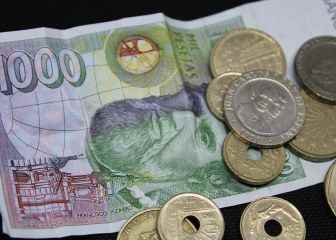Pesetas were officially discontinued in 2002, with the entry of Spain into the euro zone. Two decades later, millions of euros in pesetas have not changed. From June 31, 2021 pesetas cannot be exchanged for eurossince it ended term of the Bank of Spain for this management. The deadline was postponed from December 31, 2020 to the following summer due to processing difficulties due to the pandemic.
It is estimated that the Spaniards have left without exchanging pesetas worth €1,575 million (the 3.2% of the value of banknotes and coins in circulation). This money has lost its value, unless it is special copies or commemorative editionsso its value is limited to that of collectibles.
The ten most traded currencies
The Peseta 1987 E-87 is the most valued piece of the series to which it belongs, minted on the occasion of the III National Numismatic Exhibition, it is made of aluminum to reduce the cost of production. It is valued at 45 euros.
the popular 100 pesetas 1983known as 20 hardreach 55 euros among collectors.
The 50 pesetas 1984large, have been revalued due to the low print run that was made compared to other models: 17,000,000 pieces. Currently they reach the value of 60 or 70 euros.
The 25 pesetas of 1995the hard five with a hole in the center of the coin due to the modernization of the design and format, they reach 100 euros per piece. These coins were dedicated each year to an Autonomous Community. In 1995, the tribute corresponded to Castile and Leon. An error in the printing of the coins (the “y” of Castilla y León was missing) gives it the value it currently presents.
The 100 pesetas of 1966 They are large coins (3.5 centimeters in diameter) minted in silver. They were manufactured in 1966, however, the most expensive of this model are those of the year 1969. These are paid for 145 euros the piecealthough there is one exception: the typographic variant that shows the stick of the number “nine” straight reaches the 400 euros.
The 5 pesetas of 1975 were made for the 82 World Cup and it is one of the most desired pieces. There was an error and in some of the coins the year 1975 appears. With this, the price for collectors is between the 350 and 400 euros.
The 50 cent 1949 E-51, with a hole in the center, had a special print run in 1951 on the occasion of the II National Numismatic Exhibition. This small print run, of about 5,000 pieces, has “E-51” engraved on it. They have a value of 500 euros.
The coins that are 1 peseta of 1947, known as blondesappeared for the first time with the effigy of the dictator Francisco Franco. The best preserved from 1956 reach a value of 1400 euros.
One of the best valued coins on the collector’s market is the 2.5 pesetas from 1953. It is not easy to find good quality pieces because the Spanish did not get used to the use of this coin with values of cents. The 2.5 peseta coin minted in 1968 round the 1700 euros.
The 5 pesetas of 1949the famous hard, they were minted until 1952. Then, the Government was forced to withdraw them because the price of the material from which they were made – nickel – became notably more expensive: they used to be melted to exchange them for money. As very few came to circulate, the coins of 1951 they are around €12,000 and those of 1952 reach the 15,000 or 20,000 euros.
What to do with these coins?
Those people who are in possession of any of these coins can sell them by going to a coin shop or auction house (either face-to-face or online). Businesses dedicated to the exchange of collectible pieces or coin auctions serve to find out the real price of the piece, show the possible value and facilitate the possible purchase-sale.
